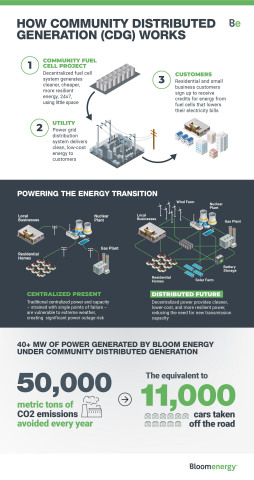Bloom Energy to Power Communities with Sustainable and Resilient Electricity; Consumers Benefit from Increased Choice, Lower Cost
Bloom Energy (NYSE: BE) today announced it has begun to deploy a portfolio of more than 40 megawatts of solid oxide fuel cells in the Northeast through a series of agreements under a Community Distributed Generation (CDG) program, which encourages investment and deployment of clean energy technologies. The initial portfolio of projects is being deployed in New York.

How Community Distributed Generation (CDG) Works (Graphic: Bloom Energy)
The current CDG program incentivizes developers to install clean power generation within the grid distribution network to alleviate stress on the electric grid, decrease harmful greenhouse gas emissions and air pollutants, reduce costs, and enhance energy reliability. Consumers, meanwhile, can purchase cleaner, more affordable and resilient power.
CDG customers will receive utility bill credits for using power produced by Bloom’s Energy Servers. Customers – particularly small businesses with smaller loads and residential customers – will now have greater choice and access to cost-effective and more resilient energy sources. Utilities benefit from increased grid resiliency and lower transmission and distribution infrastructure outlays, as the power generation system is located within the distribution infrastructure.
In addition to providing cost savings and improving power reliability, Bloom’s Energy Servers are expected to reduce carbon emissions by nearly 50,000 metric tons annually compared to the current grid alternative – the equivalent to taking more than 11,000 cars off the road for one year. Bloom Energy’s servers produce electricity through a highly-efficient, non-combustion process, so smog-forming pollutants and particulate matter are reduced by more than
“Community distributed generation can be a national model to provide small businesses and residential customers greater access and choice for clean and reliable power generation sources,” said Ivor Castelino, managing director, business development, Bloom Energy. “These types of projects allow Bloom to provide clean power in a small footprint with enhanced resiliency to customers who, otherwise, have not had a choice for their energy needs. Bloom’s compact, easily deployed energy solutions are ideally suited to highly populated areas, where reducing greenhouse gas and air pollution, while enhancing reliability of the local electric grid, are of paramount importance.”
Bloom has signed agreements for CDG projects totaling more than 40 megawatts in various stages of development, with 7.5 megawatts already deployed on Staten Island, New York. Bloom Energy’s development partners and investors in these projects include Captona, Daroga Power, NineDot Energy, and South Jersey Industries, among other partners.
“Bloom Energy provides Captona the ideal growth technology and long-term reliability for our sustainable investing goals in clean and renewable projects,” said Izzet Bensusan, founder and managing partner, Captona. “As a current owner and operator of multiple projects, we foresee additional expansion in our investments with Bloom and their upcoming solutions, such as bringing hydrogen to our portfolio mix.”
"Coupling Daroga Power’s expertise in distributed energy generation and structured finance along with Bloom’s cleaner and more resilient energy is a game changer for New York communities,” said David Matt and Ory Moussaieff, co-founders, Daroga Power. “Supporting our nation’s goals to provide reliable power and combat climate change, we look forward to continuing to deploy such innovative energy sources throughout the country."
“Our communities deserve greater choice and clean energy options,” said David Arfin, co-founder and CEO of NineDot Energy. “By partnering with Bloom, we are proud to bring sustainable and reliable energy to New Yorkers, accelerating NineDot’s position as a leading developer of distributed energy solutions in New York City.”
“Our employees, customers, shareholders and regulators are looking to us for the cleanest energy solutions we can deliver. SJI is committed to advancing positive environmental outcomes, including reducing carbon emissions, promoting energy efficiency, and enhancing the deployment of clean energy technologies,” said Mike Renna, CEO and president, SJI. “Our partnership with Bloom helps us take an additional step in our efforts to build a clean energy future in our region.”
About Bloom Energy
Bloom Energy’s mission is to make clean, reliable energy affordable for everyone in the world. The company’s product, the Bloom Energy Server, delivers highly reliable and resilient, always-on electric power that is clean, cost-effective, and ideal for microgrid applications. Bloom’s customers include many Fortune 100 companies and leaders in manufacturing, data centers, healthcare, retail, higher education, utilities, and other industries. For more information, visit www.bloomenergy.com.
Cautionary Note Regarding Forward-Looking Statements
This press release contains forward-looking statements within the meaning of the federal securities laws that involve risks and uncertainties, including Bloom Energy’s expectations regarding reduced carbon emissions and ability to enhance the reliability of the local electric grid; and Bloom Energy’s expectations that CDG can be a national model to provide small businesses and residential customers greater access and choice for clean and reliable power generation sources. Words such as “anticipates,” “could,” “expects,” “intends,” “plans,” “projects,” “believes,” “seeks,” “estimates,” “can,” “may,” “will,” “would” and similar expressions identify such forward-looking statements. These statements should not be taken as guarantees of results and should not be considered an indication of future activity or future performance. Actual events or results may differ materially from those described in this press release due to a number of risks and uncertainties, including those included in the Risk Factors section of Bloom Energy’s Annual Report on Form 10-K for the year ended December 31, 2020 and other risks detailed in Bloom Energy’s SEC filings from time to time. Bloom Energy undertakes no obligation to revise or publicly update any forward-looking statements unless if and as required by law.
View source version on businesswire.com: https://www.businesswire.com/news/home/20210330006011/en/







